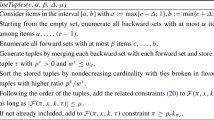Abstract
We consider the Bilevel Knapsack with Interdiction Constraints, an extension of the classic 0-1 knapsack problem formulated as a Stackelberg game with two agents, a leader and a follower, that choose items from a common set and hold their own private knapsacks. First, the leader selects some items to be interdicted for the follower while satisfying a capacity constraint. Then the follower packs a set of the remaining items according to his knapsack constraint in order to maximize the profits. The goal of the leader is to minimize the follower’s profits. The presence of two decision levels makes this problem very difficult to solve in practice: the current state-of-the-art algorithms can solve to optimality instances with 50–55 items at most. We derive effective lower bounds and present a new exact approach that exploits the structure of the induced follower’s problem. The approach successfully solves all benchmark instances within one second in the worst case and larger instances with up to 500 items within 60 s.
Access this chapter
Tax calculation will be finalised at checkout
Purchases are for personal use only
Similar content being viewed by others
References
Brotcorne, L., Hanafi, S., Mansi, R.: One-level reformulation of the bilevel knapsack problem using dynamic programming. Discrete Optim. 10, 1–10 (2013)
Caprara, A., Carvalho, M., Lodi, A., Woeginger, G.: Bilevel knapsack with interdiction constraints. INFORMS J. Comput. 28, 319–333 (2016)
Carvalho, M., Lodi, A., Marcotte, P.: A polynomial algorithm for a continuous bilevel knapsack problem. Oper. Res. Lett. 46, 185–188 (2018)
Chen, L., Zhang, G.: Approximation algorithms for a bi-level knapsack problem. Theor. Comput. Sci. 497, 1–12 (2013)
Della Croce, F., Scatamacchia, R.: A new exact approach for the bilevel knapsack with interdiction constraints (2018). http://arxiv.org/abs/1811.02822
DeNegre, S.: Interdiction and discrete bilevel linear programming. Ph.D. thesis. Lehigh University (2011)
Fischetti, M., Ljubić, I., Monaci, M., Sinnl, M.: Interdiction games and monotonicity, with application to knapsack problems. INFORMS J. Comput. (2018, to appear), technical report available at: https://homepage.univie.ac.at/ivana.ljubic/research/publications/interdiction_games_and_monotonicity.pdf
Fischetti, M., Monaci, M., Sinnl, M.: A dynamic reformulation heuristic for generalized interdiction problems. Eur. J. Oper. Res. 267, 40–51 (2018)
Martello, S., Pisinger, D., Toth, P.: Dynamic programming and strong bounds for the 0-1 knapsack problem. Manag. Sci. 45, 414–424 (1999)
Pisinger, D.: A minimal algorithm for the 0-1 knapsack problem. Oper. Res. 45, 758–767 (1997)
Stackelberg, H.V.: The Theory of the Market Economy. Oxford University Press, Oxford (1952)
Author information
Authors and Affiliations
Corresponding author
Editor information
Editors and Affiliations
Appendix
Appendix


Rights and permissions
Copyright information
© 2019 Springer Nature Switzerland AG
About this paper
Cite this paper
Della Croce, F., Scatamacchia, R. (2019). Lower Bounds and a New Exact Approach for the Bilevel Knapsack with Interdiction Constraints. In: Lodi, A., Nagarajan, V. (eds) Integer Programming and Combinatorial Optimization. IPCO 2019. Lecture Notes in Computer Science(), vol 11480. Springer, Cham. https://doi.org/10.1007/978-3-030-17953-3_12
Download citation
DOI: https://doi.org/10.1007/978-3-030-17953-3_12
Published:
Publisher Name: Springer, Cham
Print ISBN: 978-3-030-17952-6
Online ISBN: 978-3-030-17953-3
eBook Packages: Computer ScienceComputer Science (R0)





